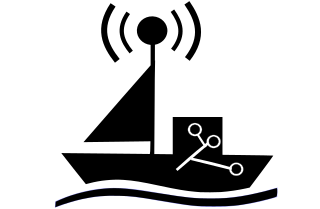
The Turkish Naval Forces, or Turkish Navy, is the naval warfare service branch of the Turkish Armed Forces.

Aselsan A.Ş. is a Turkish defense corporation headquartered in Ankara, Turkey. Its main operating area is research, development and manufacture of advanced military products for air, land and maritime forces. The company is one of the major contractors of the Turkish Armed Forces. Aselsan was ranked by Defense News as the 48th largest defense company in terms of revenue. The Turkish Army Foundation is the founder, and it's successor, the Turkish Armed Forces Foundation, is the major stockholder.

An unmanned surface vehicle, unmanned surface vessel or uncrewed surface vessel (USV), colloquially called a drone boat, drone ship or sea drone, is a boat or ship that operates on the surface of the water without a crew. USVs operate with various levels of autonomy, from remote control to fully autonomous surface vehicles (ASV).
The TF-2000-class destroyer is a projected anti-air warfare guided-missile destroyer currently undergoing development by the Turkish Naval Institute. The class will provide survivability in the presence of aerial threat and also support mission functions such as command, control, and communications, reconnaissance, early warning, surface warfare, anti-submarine warfare and electronic warfare. Moreover, once in service, the TF-2000s are slated to be an integral part of Türkiye's expeditionary strike groups centered around the TCG Anadolu LHD and the country's future aircraft carrier(s). The TCG Anadolu is to be followed up by the TCG Trakya light aircraft carrier and President Erdoğan has also hinted at the construction of a larger aircraft carrier that is to be designed in cooperation with Spain. These capital vessels require destroyer escorts to defend them against enemy aircraft, ships and submarines; in other words, the perfect role for the TF-2000s once these new designs are slated for operational service by 2038. On 5 December 2007, Defence Industry Executive Committee approved plans to build six ships of this class. In January 2013, it was announced that Turkey was planning to acquire a total of 8 TF-2000 destroyers, which was confirmed at the International Defence Industry Fair (IDEF) 2021. With the realization of the project, it is intended to improve the anti-air warfare (AAW) capabilities of the Turkish Navy.

The ASW Continuous Trail Unmanned Vessel (ACTUV) is a DARPA funded project launched in early 2010 to develop an anti-submarine drone. ASW is an acronym for Anti-Submarine Warfare. In January 2018 after successful sea trials it was announced that the "Sea Hunter" prototype has transitioned from DARPA to the Office of Naval Research for further development.

The Fleet-class unmanned surface vessel, also called the Common Unmanned Surface Vessel (CUSV) and later the Mine Countermeasures Unmanned Surface Vehicle, is an unmanned surface vessel designed for the United States Navy to be deployed from Freedom and Independence-class littoral combat ships and intended to conduct mine and anti-submarine warfare missions. As of 2012 four units of the class have been built; the first was delivered to the U.S. Navy in 2008.
Seaborne targets are vessels or floating structures that are shot at for practice by naval or air forces. They may be remotely controlled and mobile, or towed behind other craft, or just set adrift in the sea.

Sea Hunter is an autonomous unmanned surface vehicle (USV) launched in 2016 as part of the DARPA Anti-Submarine Warfare Continuous Trail Unmanned Vessel (ACTUV) program. The ship was christened 7 April 2016 in Portland, Oregon. It was designed and built by Leidos. The vessel continues the line of experimental "Sea" ships, including Sea Shadow, Sea Fighter, Sea Jet, and Sea Slice. Sea Hunter is classified as a Class III USV and designated the Medium Displacement Unmanned Surface Vehicle (MDUSV).
ULAQ is the prototype of the first Turkish armed unmanned surface vessel (AUSV).
The JARI USV is an uncrewed surface vehicle developed by the China Shipbuilding Industry Corporation (CSIC), specifically between its No. 716 Research Institute, the Jiangsu Automation Research Institute (JARI), and No. 702 Research Institute, China Ship Scientific Research Centre (CSRRC). The uncrewed warship is designed for potential use for the People's Liberation Army Navy and export customers.
The Babur-class corvette, also known as the PN MILGEM class, is a class of four heavy corvettes under construction for the Pakistan Navy. This class is a subclass of the Turkish MILGEM project. The corvette class is heavier and larger than the Turkish Ada-class corvette and are also equipped with VLS.

The GOKDENIZ complex along with Aselsan ATOM 35mm airburst ammunition is an all-weather-capable Turkish 35 mm dual barrel close-in weapon system (CIWS) developed by Aselsan. It is a CIWS variant of KORKUT Self-propelled anti-aircraft gun.

Ghost Fleet Overlord is a fleet of test unmanned surface vehicles operated by the U.S. Navy.

The Bayraktar Kızılelma is a single-engine, low-observable, carrier-capable, jet-powered unmanned combat aerial vehicle (UCAV), currently in development by Turkish defense company Baykar. The aircraft is being developed as part of Project MIUS. The initial Bayraktar Kızılelma (Kızılelma-A) is subsonic. Planned variants are intended to be supersonic, the latter having a twin-engined configuration. It is one of the two Turkish jet-powered stealth UCAV along with TAI Anka-3.
MAGURA V5 is a Ukrainian multi-purpose unmanned surface vehicle (USV) developed for use by the Main Directorate of Intelligence of Ukraine (HUR) capable of performing various tasks: surveillance, reconnaissance, patrolling, search and rescue, mine countermeasures, maritime security, and combat missions.
Sancar SİDA is a Turkish unmanned combat surface vessel (UCSV) of the Turkish Navy.
TCB Marlin SİDA (TCB-1101) is a Turkish unmanned combat surface vessel (UCSV) of the Turkish Naval Forces, commissioned in January 2024.
Albatros-S is a Turkish unmanned surface vessel (USV) swarm of the Turkish Navy developed by the Turkish defense company Aselsan.
Albatros USV family consists of high-speed unmanned surface seaborne targets of catamaran-type Albatros-K, swarm-type Albatros-S and V-hull-type Albatros-T built by the Turkish defense company Aselsan for the needs of the Turkish Naval Forces.








